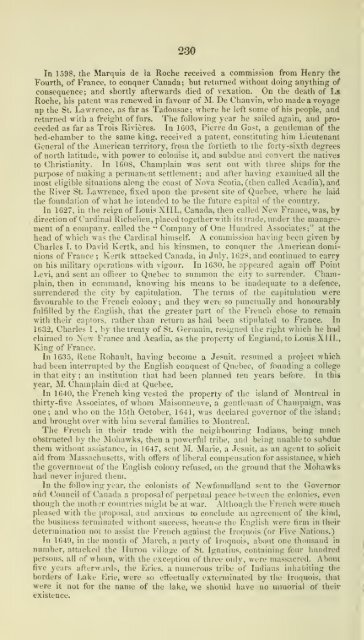Smith's Canadian gazetteer - ElectricCanadian.com
Smith's Canadian gazetteer - ElectricCanadian.com
Smith's Canadian gazetteer - ElectricCanadian.com
You also want an ePaper? Increase the reach of your titles
YUMPU automatically turns print PDFs into web optimized ePapers that Google loves.
230<br />
In 1598, the Marquis de la Roche received a <strong>com</strong>mission from Henry tht<br />
Fourth, of France, to conquer Canada; but returned without doing anything o(<br />
consequence; and shortly afterwards died of vexation. On the death of La<br />
Roche, his patent was renewed in favour of M. De Chauvin, who made a voyage<br />
up the St. Lawrence, as far as Tadousac; where he left some of his people, and<br />
returned with a freight of furs. The following year he sailed again, and pro*<br />
ceeded as far as Trois Rivieres. In 1603, Pierre du Gast, a gentleman of the<br />
bed-chamber to the same king, received a patent, constituting him Lieutenant<br />
General of the American territory, from the fortieth to the forty-sixth degrees<br />
of north latitude, with power to colonise it, and subdue and convert the natives<br />
to Christianity. In 1608, Champlain was sent out with three ships for the<br />
purpose of making a permanent settlement; and after having examined all the<br />
most eligible situations along the coast of Nova Scotia, (then called Acadia), and<br />
the River St. Lawrence, fixed upon the present site of Quebec, where he laid<br />
the foundation of what he intended to be the future capital of the country.<br />
In 1627, in the reign of Louis XIII., Canada, then called New France, was, by<br />
direction of Cardinal Richelieu, placed together with its trade, under the management<br />
of a <strong>com</strong>pany, called the Company '' of One Hundred Associates;" at the<br />
head of. which was the Cardinal himself. A <strong>com</strong>mission having been given by<br />
Charles I. to David Kertk, and his kinsmen, to conquer the American dominions<br />
of France ; Kertk attacked Canada, in July. 1628, and continued to carry<br />
on his military operations with vigour. In 1630, he appeared again off Point<br />
Levi, and sent an officer to Quebec to summon the city to surrender. Champlain,<br />
then in <strong>com</strong>mand, knowing his means to be inadequate to a defence,<br />
surrendered the city by capitulation. The terms of the capitulation were<br />
favourable to the French colony; and they were so punctually and honourably<br />
fulfilled by the English, that the greater part of the French chose to remain<br />
with their captors, rather than return as had been stipulated to France. In<br />
1632, Charles I , bj- the treaty of St. Germain, resigned tlie right which he had<br />
claimed to New France and Acadia, as the property of England, to Louis XIII.,<br />
King of France.<br />
In 163.5, Rene Rohault, having be<strong>com</strong>e a Jesuit, resumed a project which<br />
had been interrupted by the English conquest of Quebec, of founding a college<br />
in that city ; an institution that had been planned ten years before. In this<br />
year, M. Champlain died at Quebec.<br />
In 1640, the French king vested the property of the island of Montreal in<br />
thirty-five Associates, of whom Maisonneiive, a gentleman of Champaign, was<br />
one; and Avho on the 15th October, 1641, was declared governor of the island;<br />
and brought over with him several families to Montreal.<br />
The P^rench in their trade with the neighbouring Indians, being much<br />
obstructed by the Mohawks, then a powerful tribe, and being unable to subdue<br />
them without assistance, in 1647, sent M. Marie, a Jesuit, as an agent to solicit<br />
aid from Massachusetts, with offers of liberal <strong>com</strong>pensation for assistance, which<br />
the governuuMit of the English colony refused, on the ground that the Mohawks<br />
had never injui-ed them.<br />
In the following year, the colonists of Newfoundland sent to the Governor<br />
ahd Council of Canada a proposal of perpetual peace between the colonies, even<br />
though the mother countries might be at war. Although the French were much<br />
pleased with the proposal, and anxious to conclude an agreement of the kind,<br />
the business terminated without success, because the English were firm in their<br />
determination not to assist the French against the Iroquois (or Five Nations.)<br />
In 1640, in the month of March, a party of Iroquois, about one thousand in<br />
number, attacked the Huron village of St. Ignatius, containing four hundred<br />
persons, all of whom, with the ('xeei)tion of three only, were massacred. About<br />
five years aftcrw.irds, the Eries, a numerous tiibc of Indians inhabiting the<br />
borders of Lake Erie, were so etl'ectually extenninated by the Iroquois, that<br />
were it not for the name of the lake, we should have no mmorial of their<br />
existence.

















